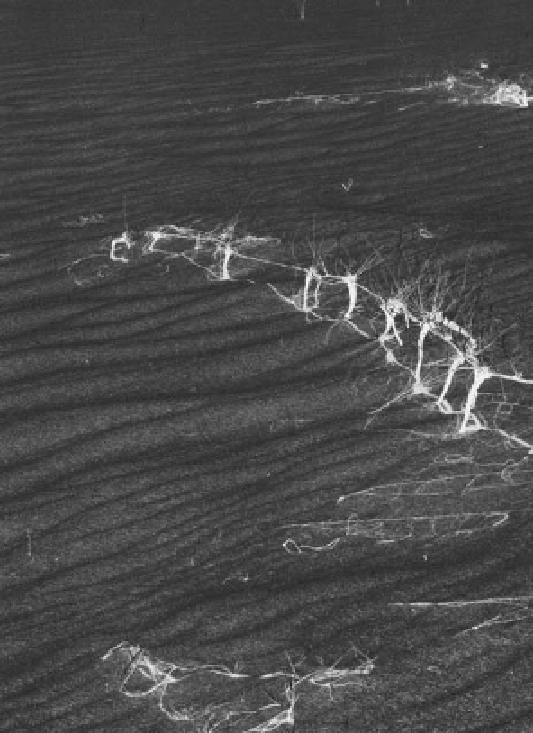Geoscience Reference
In-Depth Information
attracted to the dunes for this reason, including deer, elk,
waterfowl, and wild horses. the ponds also provide habi-
tat for various aquatic organisms, including salamanders,
spadefoot toads, and freshwater shrimp. Because dunes
are an oasis in the semi-arid basins and plains, livestock
may concentrate there, creating management problems
similar to those encountered in riparian landscapes.
indigenous people were also attracted to the dunes,
Artifacts, estimated at more than 10,000 years old, have
been found in the Killpecker Dunes and elsewhere in the
region, commonly in association with bison bones.
Although sand dunes are favorable for the growth of
established plants, shifting sands provide a poor sub-
strate for seedling establishment. Moreover, established
plants are easily buried. Pioneer dune plants (such as
blowout grass and scurfpea) survive because their rhi-
zomes grow up or down quickly enough to maintain
appropriate depths for the species. Aside from that, root
growth occurs in the direction of moisture availability.
As important, the rhizomes have considerable energy
stored in the form of carbohydrates, which enables the
growth of numerous shoots when the buds begin to
grow, all characteristics that diminish the probability
that the entire plant will be buried to excessive depths.
Roots also grow from the buried vertical stems of some
plants (adventitious roots), even on seedlings.
12
Dune plants encounter other problems as well, such
as sandblasting of their leaves and stems. not surpris-
ingly, most of them are herbaceous, with shoots that
require maintenance for only a few months. Also, some
species produce waxy coatings that reduce abrasion by
blowing sand. Unlike in the coppice dunes discussed
in chapter 7, woody plants invade only after the dunes
have become partially stabilized and abrasion is less
severe. Sand abrasion is not all bad for the plants, as
some of them have seeds that will not germinate until
seed coats are abraded. other adaptations contribute
to water-use efficiency in this environment, where the
temperature at the soil surface can be high. Many dune
plants are water-efficient c
4
species, and a large propor-
tion have both shallow and deep roots.
13
extensive root systems with mycorrhizae are impor-
tant for obtaining nutrients, as sand is an infertile sub-
strate. Also, two common dune colonizers in Wyoming
Fig. 9.4. Slimflower scurfpea. note the rhizome and promi-
nent taproots that have been exposed by wind erosion.
favorable for the survival of many plants and animals.
the annual production of new plant biomass can be
even with limited precipitation, the rapid infiltration
of water through the coarse sand provides good water
storage, and commonly snowdrifts on the lee sides of
dune crests are buried by drifting sand in the spring. it
is common to find buried snow in midsummer, which
provides a source of water for ponds and perennial
further by the shrubs and small trees that occur along
such streams, for example, basin big sagebrush, com-
mon juniper, currant, oregon-grape, Rocky Mountain
juniper, water birch, Woods' rose, and willow.
Rapid infiltration reduces the time available for evap-
oration. this, along with buried snow that melts slowly
during the summer, contributes to the formation of small
ponds between the dunes (fig. 9.5). Many animals are

Search WWH ::

Custom Search